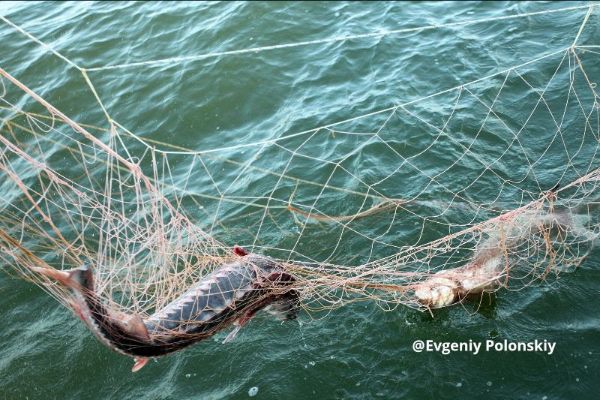Wildlife Trafficking Of Critically Endangered Sturgeon

WILDLIFE TRAFFICKING OF CRITICALLY ENDANGERED STURGEON – NEW EVIDENCE OF SYSTEMATIC VIOLATIONS FROM THE LOWER DANUBE REGION
Almost a third of the samples of sturgeon products bought through WWF's market survey were illegal, and 214 cases of poaching related incidents were recorded by authorities.
WWF's new market survey provides first-time evidence of the actual scale of poaching and illegal trade of meat and caviar from wild-caught sturgeon in the Lower Danube Region; specifically in Bulgaria, Romania, Serbia and Ukraine. This is one of the last places on Earth where critically endangered sturgeons survive and still reproduce. Illegal sturgeon fishing and trade in their products are often cited as significant threats to many sturgeon populations worldwide. However, until now, substantiated data has rarely been available. The survey provides proof that illegal fishing and trade in wild sturgeon is happening on a regional level and on a rather serious scale. The unique survey methodology combined official data on illegal fishing activities from competent authorities and the results of a large-scale market survey and forensic analysis of meat and caviar samples in Bulgaria, Romania, Serbia and Ukraine between October 2016 and July 2020.
“Very few market surveys on the sturgeon trade exist, and this is the only one so far that combines 2 state-of-the-art forensic methods, which is crucial to detect illegal trade.” says Arne Ludwig, IZW genetics expert, Co-Chair IUCN Sturgeon Specialist Group and co-author of the report.
Samples were collected at different locations from sturgeon populations that share the same migratory routes along the entire trade chain on the Lower Danube and in the north-western Black Sea region. Testing points included various types of retailers such as shops and supermarkets, restaurants and bars, local markets, aquaculture facilities, intermediaries, fishermen and online offers. All samples underwent DNA[1] and isotope testing.
Read Report
Results and Conclusions
- Isotope analysis proved that wild sturgeon products were being sold in all four countries. Of the 145 samples tested, 19% (27 out of all 145) proved to be from wild sturgeon - 25 were meat and 2 were caviar;
- 17 samples of caviar (12% of all samples and 29% of all caviar samples) were sold without : illegal import into the country of purchase, sold without mandatory CITES labelling, or not having correct codes for species or country of origin;
- Suppliers (salespersons, waiters, etc.) provided deceptive information. In one case, meat sold as farmed was proven to be wild. The reverse was also true in several cases when products declared as wild sturgeon proved to be farmed, or to be meat from European catfish or Nile perch. This indicates a worrying consumer demand for illegal, wild-caught sturgeon products; and
- Even though all fishing and trade of wild Danube sturgeon species was prohibited in Bulgaria, and only the catch of Sterlet above 40 cm total length was allowed in Serbia until the end of 2018, 214 cases of illegal poaching-related incidents were recorded in Romania (82 cases), Bulgaria (82 cases) and Ukraine (50 cases) between January 2016-December 2020.2 These incidents included seizures of illegal fishing gear for targeting sturgeon, seizures of actual sturgeon in boats or fishing nets, transportation of poached sturgeon, and sale of caviar or meat of poached sturgeon. In Bulgaria alone, 594 illegal hook lines were detected, adding up to more than 23.5 km. Just last month there were several new reported poaching cases in Ukraine and Romania.
“This is the first assessment of the volume of sturgeon poaching and trade along the lower Danube and Black Sea – and even if we have to assume that we found just the tip of the iceberg, it shows how serious the impact on the last wild sturgeons still is and how crucial our fight is to save them.” - Jutta Jahrl, WWF Project Manager
Recommendations
- Enhanced controls of domestic trade;
- Control of CITES caviar labelling requirements;
- Improved inter-agency cooperation and coordination;
- Increased border controls;
- Use of State-of-the-art forensic analysis; and
- Conducting more and recurrent market surveys.
Read Report
The survival of these highly threatened wild sturgeon species in Central and Eastern Europe is dependent on continuous and increased efforts to reduce the threat of wild sturgeon trafficking. WWF’s report is designed with the aspiration to shed light on the situation, inform responsible actors, contribute to the intelligence for future enforcement activities, foster the exchange of relevant data among different authorities and between sturgeon range countries, and encourage regular market surveys by the responsible authorities. Opportunities must be seized under the EU Biodiversity Strategy and the upcoming UN Convention on Biological Diversity (CBD) conference in Kunming, China to shut down illegal wildlife trade and preserve freshwater ecosystems in Europe and abroad.


 Sonali Kolhatkar, IMI: What Is Our Collective Solution To Health Injustice?
Sonali Kolhatkar, IMI: What Is Our Collective Solution To Health Injustice? Cook Islands Investment Incorporation: Government Partners With Communities To Improve Safety Shelters
Cook Islands Investment Incorporation: Government Partners With Communities To Improve Safety Shelters Richard D. Wolff, IMI: Political Economy Contradictions As We Lurch Into 2025
Richard D. Wolff, IMI: Political Economy Contradictions As We Lurch Into 2025 People with Disability Australia - PWDA: CMHA And PWDA Demand Justice And Urgent Reform Following Death Of Simon Cartwright At Silverwater Jail
People with Disability Australia - PWDA: CMHA And PWDA Demand Justice And Urgent Reform Following Death Of Simon Cartwright At Silverwater Jail UNICEF Aotearoa NZ: Vanuatu Quake - UNICEF Aotearoa Launches Urgent Fundraising Appeal For 40,000 Children In Need
UNICEF Aotearoa NZ: Vanuatu Quake - UNICEF Aotearoa Launches Urgent Fundraising Appeal For 40,000 Children In Need New Zealand Defence Force: Surveillance, Aid, Responders And Evacuees Covered By RNZAF Vanuatu Flights
New Zealand Defence Force: Surveillance, Aid, Responders And Evacuees Covered By RNZAF Vanuatu Flights